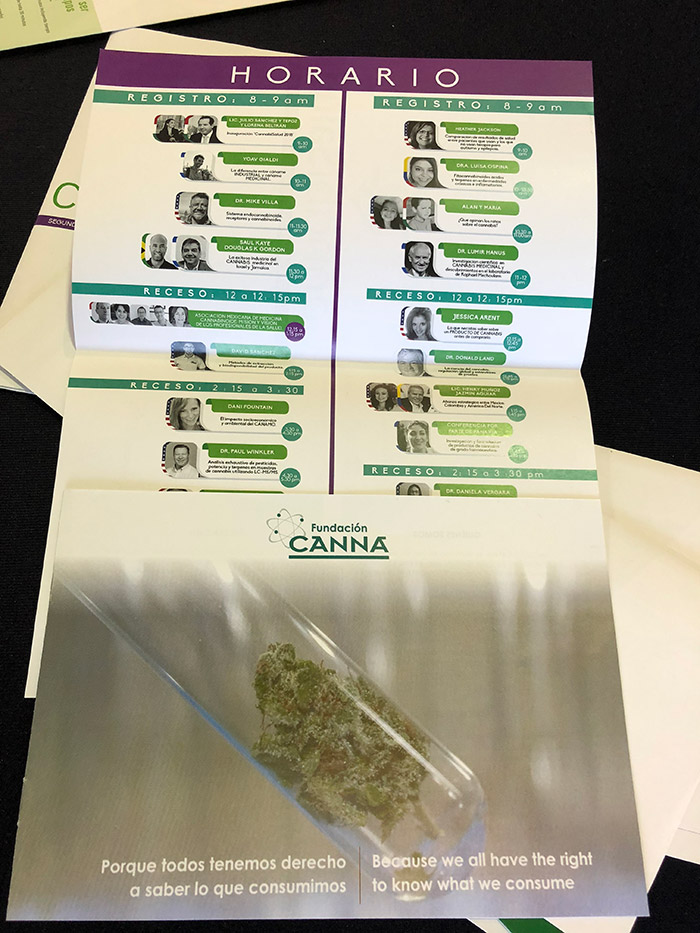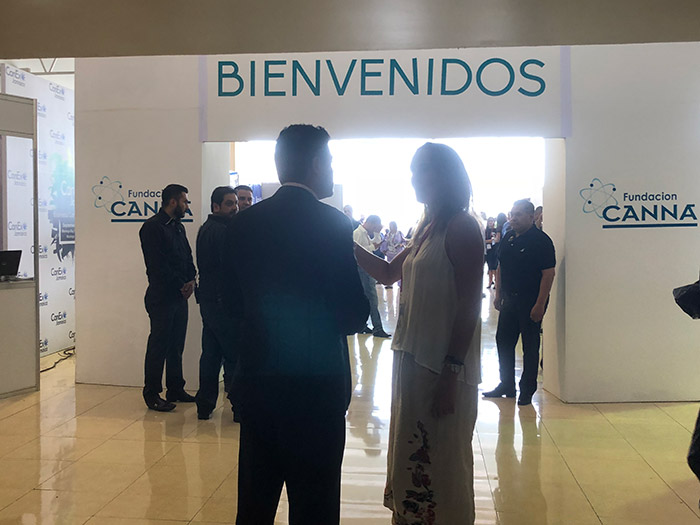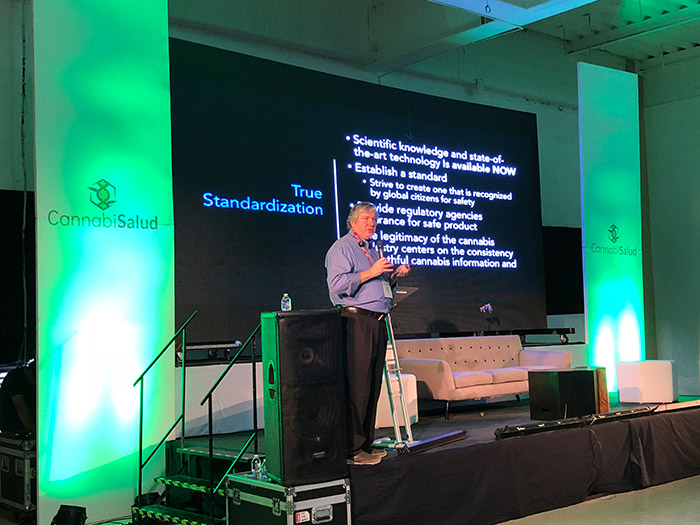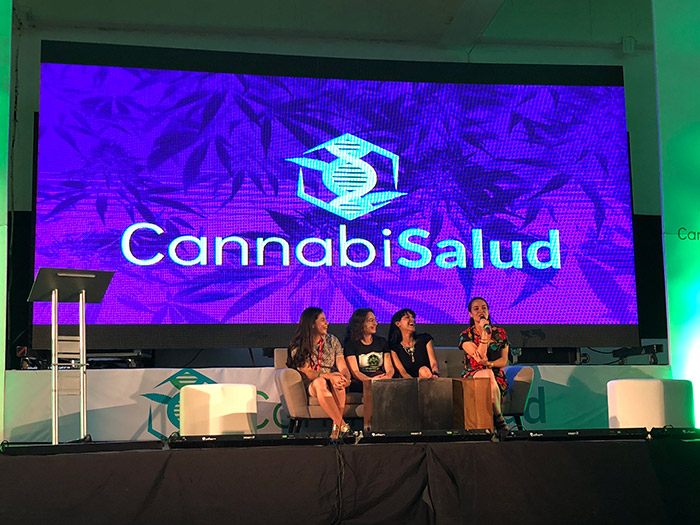Courtesy Cáñamo México
CannabiSalud 2018 took place last weekend in the City of Mexico. It was the second symposium for health professionals that brought together leading researchers, doctors and health caregivers, non-profit organisations, activists and companies with their Mexican counterparts who are interested to participate in developing knowledge and practice of medicinal cannabis and to create a Mexican pharmaceutical industry based on cannabis.

Unlike other medical cannabis conferences in the region, CannabiSalud is a two-day meeting specifically designed for health professionals such as doctors, nurses, therapists and pharmacists. Another feature of this symposium is the variety of areas covered: genomics, regulation, history, the endocannabinoid system, types of products, research and even aspects of plant chemistry and its role in human treatments. Given the profile of the attendees, many of the talks and lectures addressed the benefits of using cannabis in patients with various medical conditions such as autism, cancer, chronic pain, epilepsy, psychosis and a wide variety of other chronic conditions.
In Mexico, which is currently in a process of regulating cannabis research and medical use, CannabiSalud enables professionals to obtain knowledge about cannabis as a new therapeutic option, with information about the latest advances, the benefits and experiences of medical use that are already in daily practice in other nations.

On 19 June 2017, the President of Mexico published the law that enables medical use and scientific research with cannabis. This reform also authorises the import of derivative products with less than 1% tetrahydrocannabinol. However, the implementation of this law goes through a secondary regulation by the Federal Commission for the Protection against Health Risks (Cofepris) –dependent on the Health Ministry–, an organisation that, in theory, should have published it 180 days later; that is, in December last year. A first version of the General Health Law Regulation on Health Control of Cannabis and its Derivatives was published in November for public consultation. The director and the legal coordinator of the agency argue that the delay –which has been disappointing among patient groups– is due to the Federal Commission for Regulatory Improvement (Cofemer) receiving more than 160 comments received from citizens, civil organisations and other government agencies.
However, during the Cofepris presentation at CannabiSalud, it was announced that the health licenses for planting, growing and harvesting in Mexican territory will be exclusively for medical and research use. It was also pointed out that the products to be imported should be standardised and, if they contain more than 1% THC, the import application should be made as a psychotropic product.

For those who wish to present research protocols with standardised pharmacological products derived from cannabis, the requirements include presenting studies –which may have been carried out in foreign institutes– that prove safety and efficacy and that specify the therapeutic effect, pharmacokinetics and pharmacodynamics of the product. Cofepris representatives also informed that the National Cancer Institute (Incan) is already working on research protocols. When asked about the requirements to be met by Mexican doctors to prescribe the products that are already marketed in the United States and Colombia, among other countries, they said that these drugs must have sanitary registration or they will be considered illegal.
Despite these limitations, knowledge of medical experience and practice arouses great interest among the medical community and among the entire Mexican public, who are beginning to understand the enormous possibilities of cannabis and wish to access the benefits of this plant that has been with humanity for millennia. Therefore, several of the papers started with the basics: the definitions.
This was presented by Dani Fountain, founder of the Colorado Hemp Project and Nature's Roots projects, both focused on health and physical and mental well-being based on cannabis-derived products, who pointed out the difference that the US government makes between hemp and marijuana: While the first must have less than 0.3% THC to not be considered psychoactive, marijuana has percentages higher than that amount. In that sense, the margin that Mexican law will enable is higher (1% THC).
Lumir Hanus, a researcher at the Hebrew University, where he collaborated in the laboratory of Dr Raphael Mechoulam on developing studies to isolate different cannabinoids, began the presentation with the history of research on cannabis medicinal use. The presentation covered the history of the discovery of cannabinoids in his native Czechoslovakia where, in 1945 at the University of Palaski, the first conference on cannabis compounds was held to present the first isolated compounds, among them, one named cannabidiolic acid. He also spoke about Dr Sdenek Krejci, who detected antibacterial microorganisms in the plant. This research was a precursor to Dr Mechoulam isolating the delta 9 tetrahydrocannabinol molecule, known worldwide as THC, in 1964.

While attempting to discover how the cannabis molecules acted in the organism, the cannabinoid receptors CB1 and CB2 were identified, respectively, in 1988 and 1993.
One of the first identified compounds, produced naturally in the organism and that binds to these receptors, was anandamide, isolated by Hanus in 1992 in the former Czechoslovakia, with which he earned an invitation to collaborate in the laboratory of Dr Mechoulam. The name of this molecule is derived from the word ananda, which means "to bless life". The advances of other scientists who participated in various studies, such as Ester Fride, who demonstrated that anandamide intervenes in the bone system, gave rise to the discovery of the endocannabinoid system, which greatly contributes to the balance of health in the body. So the importance of THC and cannabinoids to human health is summarised in Mechoulam's phrase shared by Dr Lumir Hanus in CannabiSalud: "What THC does, anandamide also does" and, as a whole, it maintains the organism in balance by helping, in the words of Dr Hanus, to "relax, eat, sleep, forget and protect".
However, the researcher called for caution and to always keep in mind that although cannabis is a wonderful medicine, it does not always cure, it does not cure everyone, it does not cure any disease and it does not cure it at all stages of the different diseases. Although he did emphasise the safety of cannabinoid compounds, since the CB1 receptor is not found in the part of the brainstem responsible for cardiovascular and respiratory functions, hence it can never cause a failure in these functions, a risk frequently associated with many other drugs and, he said, there is a risk of mental illness in people. THC can, however, damage the adolescent brain, although most adolescents who abuse cannabis do not end up as psychotic adults.
Another important aspect addressed in CannabiSalud is patient care that already takes place in different places where its medicinal use is legal, as explained by Heather Jackson, co-founder and executive director of a non-profit organisation internationally recognised for supporting families with conditions that affect their health and limit their quality of life.
Dr Luisa Ospina, an analytical biologist and Colombian microbiologist, shared recipes for drinks prepared with raw cannabis to restore health, since oral ingestion of cannabinoids can help restore health due to the number of receptors that are in the colon. With these preparations, Dr Ospina seeks to bring knowledge of medicinal plants to professionals and also to users. The recipes presented over the weekend were based on raw cannabis, which contains the acid form of various cannabinoids without psychoactive effect and are also water soluble, which enables up to five times more absorption than when cooked, smoked or steamed, in addition to incorporating terpenes and flavonoids. Another advantage of consuming cannabis is that the males can be used, because the flowers of the male plant are indicated in oncological problems. Ospina pointed out the need to take precautions in consuming the roots, since they receive nutrients as well as contaminants, although he did not rule out their consumption in topical use liniments prepared with roots and stems.

The Mexican Association of Cannabinoid Medicine made a presentation during CannabiSalud with the aim of uniting Mexican doctors in demanding the right to access cannabis for patients and health professionals. At the end of the symposium, a panel of four Mexican doctors presented their experience in the treatment with these compounds, in which an improvement and increase in the quality of life was evident.
In total, there were 25 speakers who presented the most advanced knowledge of cannabis worldwide, among them evolutionary biologist Daniela Vergara, Israeli biologist Yaov Giladi, Colombian doctor and researcher Juan Carlos Restrepo, analytical chemist Paul Winkler, among other scientists and specialists in the field.
In the regulatory and policy aspect of cannabis, apart from the representatives of Cofepris, former deputy Fernando Belaunzarán and Zara Snapp participated to talk about the reality that is approaching with the end of the prohibition. Henri Muñoz, a Colombian lawyer, explained the current regulation in Colombia, while Jazmín Aguiar did the same with the current reality in the United States by outlining the way in which the dispensaries and all the institutions that are involved are supplied.
A new feature of CannabiSalud was the participation of children who spoke about their perspective of medicinal cannabis, what their school reality is like and how their companions' perception has changed. Alan Beltrán and María Spinel, ten years old, presented the cases of other children who have already been already treated with medicinal cannabis. Undoubtedly an important point of view from those who will inherit the laws and practices that are promulgated now.


